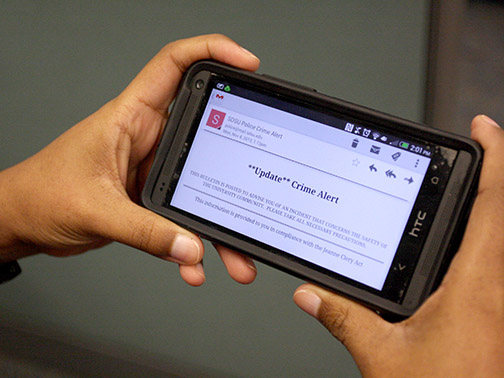The Afrikan Student Excellence Council recently held meetings to discuss the possibility of racial profiling in the San Diego State University Police Department’s crime alerts.
After several discussions regarding the issue of racial profiling in Africana studies major and minor classes, the ASEC organized a town hall meeting, reaching out to cultural organizations across campus for their input and participation, Association of Africana Studies Majors and Minors President Shellie Stamps said.
“The main concern, which was the cause for the meeting, was racial profiling,” Stamps said. “In having the discussion, the crime alerts came out as a secondary concern.”
The first meeting took place on Oct. 26. Attendees included the Association of Chicana Activists, the Student African American Brotherhood, the Student African American Sisterhood, and Movimiento Estudiantil Chicano/a de Aztlán, as well as other parties concerned about potential profiling.
During the meeting, students offered testimonies regarding incidents in which they were victims or witnesses. Resident assistants said the ambiguity of crime alerts targeting “unidentified” African-American males caused students living in the dorms to be subjected to insensitive racial jokes and uncomfortable situations.
Exercise physiology and nutritional sciences graduate student Jonathan Cunha shared how the generic crime alerts descriptions have impacted him.
“Last year I had some of my classmates joking, ‘Oh you robbed somebody again,’” Cunha said. “People were always saying, ‘Wow these descriptions, they sound a lot like you.’”
Cunha said he doesn’t think the descriptions were effective in aiding of the capture the suspects.
“If you were to go strictly off a description, then I would fit it almost every time, so I don’t think that’s really helpful in finding somebody,” Cunha said. “Even when the suspect is white, I don’t think it’s helpful because it’s the same description, but a white person instead of a black person.”
SDSUPD Interim Chief Lamine Secka was in attendance for the last half hour of the meeting, Stamps said. Secka plans to hear the students concerns at a later date, according to Stamps.
Many students at the meeting inquired about what crimes and information are required to be released to students based on the current Jeanne Clery Disclosure of Campus Security Policy and Campus Crime Statistics Act.
According to “The Handbook for Campus Safety and Security Reporting,” the Jeanne Clery Act requires the police department to disclose the location of the crime, to whom the crimes were reported, the types of crimes that were reported and the year they occurred in reported incidents.
The three general categories that require campus disclosure are criminal offenses (which include criminal homicide, sex offenses, robberies, aggravated assaults and motor vehicle thefts) arrests and referrals for disciplinary actions and hate crimes.
Lt. Josh Mays, who writes the crime alerts using the information communicated by the officer on scene, said “the (Jeanne) Clery Act requires us to put out information, even if it’s as little as a white guy, a Hispanic guy … it doesn’t have to be a full description.”
Mays acknowledged that some of the criticism the SDSUPD has received points to the department simply providing a race or gender in the alerts. Mays said the department is required to use the sometimes limited information it receives at the time of the incident to produce alerts in a timely manner.
“We understand what the concern is—that people feel we are targeting a specific race because of the crime alerts, but that information is coming to us through the victims,” Mays said. “Someone’s skin color, and whether they are male or female, even under stress, are the most easily identifiable characteristics.”
He explained that although the alerts assist in the investigation, arrests aren’t made based solely on the information received in the responses to the alerts, but rather through police work, such as reviewing surveillance cameras in the area.
But recognizing these generic descriptions have become more frequent, showing what could be implicit prejudice, social psychology professor David Marx said.
“Implicit prejudice is the negative feelings and/or beliefs (stereotypes) about a group that people hold without being aware of it,” Marx said. “Implicit prejudice is thought to operate automatically or without effort, with little intention or control on the part of the person.”
Marx felt the controversial situation could be improved through communication.
“It is definitely a tricky issue and culpability is hard to determine in these cases. Nevertheless it is an important issue that should be explored, discussed and shared as this is the only way to improve things—through research and discourse,” Marx said.
Some attendees at the Oct. 26 meeting confessed to scapegoating the description of the suspects during a crime, when in fact, no African-American had been to blame.
African Student Excellence Council Representative Helena McAllister shared her opinion regarding the alerts.
“I understand that the SDSUPD are required to put out the crime alerts, which is fine, but unless the description of the suspect is helpful, which ‘college-aged African-American male’ is not, then there is really no point in having one,” McAllister said. “I also feel that there should be some type of policy in place, such as a ‘suspect identification’ sheet or something along those lines, to help survivors of crimes accurately describe the suspect.”
Including details about cases would hamper the investigation and may tip off the suspects, Mays explained.
“We definitely understand their concerns and perceptions, but at the same time, there are also things that we cannot share, which is frustrating for us because we want to have that working partnership and trust with the community, that’s how we get our job done,” Mays said. “Unfortunately, there are things we can’t share which would help dispel the poor perception of the crime alerts.”
Stamps shared a desire for a new approach to report suspect descriptions with the police department.
“Crime alerts are a symptom of racial profiling … If you write ‘African-American male’ it identifies everyone on campus as a suspect. We would like to work with the police department to put out more effective crime alerts,” Stamps said.
On Nov. 9, a different racial profiling town hall meeting took place focusing on the effects of changing the crime alert descriptions. ASEC, Africana Studies major and minor representatives, SAAB, SAAS, MeChA, AChA and Students for Justice in Palestine as well as other organizations were in attendance.
The groups devised a list of solutions and demands for the university and police department, but did not wish to disclose their expectations until meeting with each institution.
The next meeting organized by ASEC will be in early December, along with an organized rally.
Photo by Monica Linzmeier, photo editor









